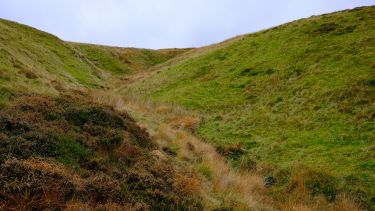Field site 1: Plynlimon, Mid Wales
Find out more about how and why we're measuring greenhouse gas removal at our sheep-grazed upland grassland site in Plynlimon, Mid Wales.

Our field site in Plynlimon is a typical sheep-grazed acidic upland grassland, which is unimproved - meaning no fertilisers or soil improvers/conditioners have been added to it. Here, we’re using two adjacent small (around 5 hectares) headwater catchments to quantify greenhouse gas removal (GGR) via ERW with crushed basalt and co-benefits for grassland production, soils and greenhouse gas (GHG) fluxes, such as carbon dioxide, nitrous oxide and methane.
The paired catchments (treatment and control) are dominated by acid podsols (infertile and acidic) with similar topography. Both their soils’ pH is around 4, they have 30-40% soil organic carbon (SOC); and their streamwater pH is around 5.6. These paired catchments are located outside the core Plynlimon monitoring areas to avoid perturbing long-term monitoring, whilst enabling these long-term records to be used as baseline reference.
How are we working on the Plynlimon field site?
In terms of timeframes, our first three months of the project were set-up time, then months 4-15 are devoted to pre-treatment monitoring of each catchment. This design, standard in catchment research, provides a paired time series of data before and after manipulation (ie, the application of basalt), and allows detection of changes in the manipulated ecosystem relative to an undisturbed reference system using randomized intervention analysis. The experimental sites are serviceable by 4-wheel drive vehicles.
We’re undertaking annual basalt applications for years 2-4 at a rate of 20 tonnes per hectare, which is equivalent to double agricultural liming rates for upland grasslands. The basalt is applied by quadbikes.
How are we measuring results of greenhouse gas removal at Plynlimon?
Each catchment is hydrologically isolated. This means that one catchment’s runoff waters don’t cross waters from the other catchment. Each catchment has a V-notch weir, which is used for continuous discharge monitoring and also flow integrated monthly runoff sampling over the four years of the project. We will quantify GGR via alkalinity generation in streamwater and test for (unlikely) carbonate formation in the soils, over 3 years.
- Continuous (24hr) carbon dioxide and methane exchange will be measured at paired locations within the control and treatment sites using specialist gas flux analysis systems, integrated with GHG analysers. The gas chambers in these pieces of equipment will provide estimates of annual net ecosystem carbon exchange, alongside monitoring how much nitrogen is emitted by the soils.
- Also, we’ll be logging continuously high-frequency meteorological and soil data (such as moisture and temperature).
- We will exploit the site design to address uncertainty in how much dissolved carbon dioxide is removed from the sites’ waters following ERW treatment: this will be done with seasonal measurement campaigns using floating chambers equipped with proven low-cost CO2 sensors deployed downstream of both treated and control catchments.
What about measuring other benefits?
We also need to see if ERW increases grass production, soil health and biodiversity. We’ll be measuring in the baseline and treatment years so we can compare the results.
- Biomass will be analysed for nutrient and forage quality annually.
- Changes in sheep movement potentially drawn to higher quality forage in basalt-treated grassland will be assessed using time lapse cameras.
- Co-benefits to soil quality will be assessed across the catchments every 6 months to a depth of 1 metre (or to a shale base layer if shallower) in years 1 and 4, and to a depth of 30 cm in years 2 and 3.
Environmental Risk Management
At our Plynlimon field site, we’re applying basalt at a rate that’s half that used on the more intensively managed lands in Field Sites 2 (North Wyke) and 3 (Harpenden) to minimize the environmental risks of overland flow causing sediment run-off into streams. We will also assess potential ERW impacts on grassland species composition and diversity, drainage water quality, and benthic invertebrates.
